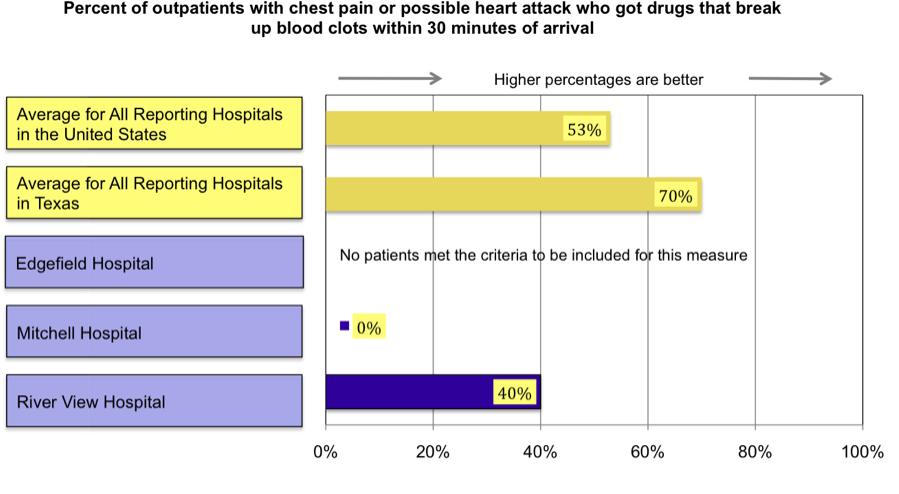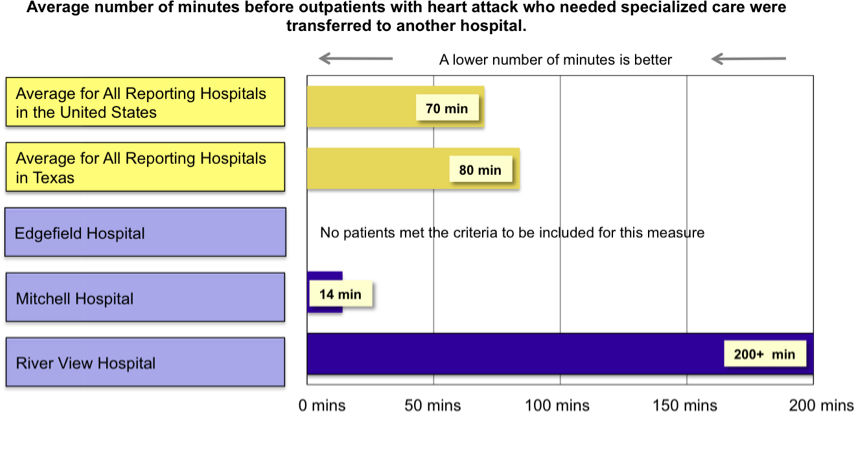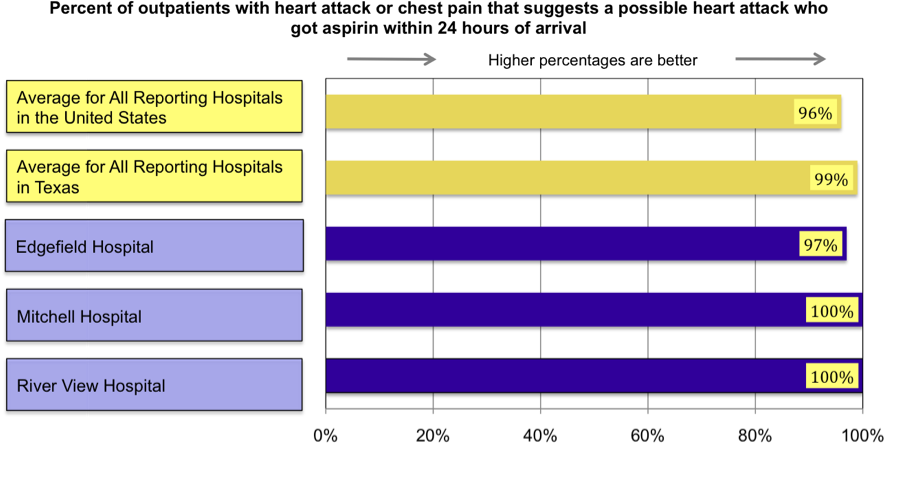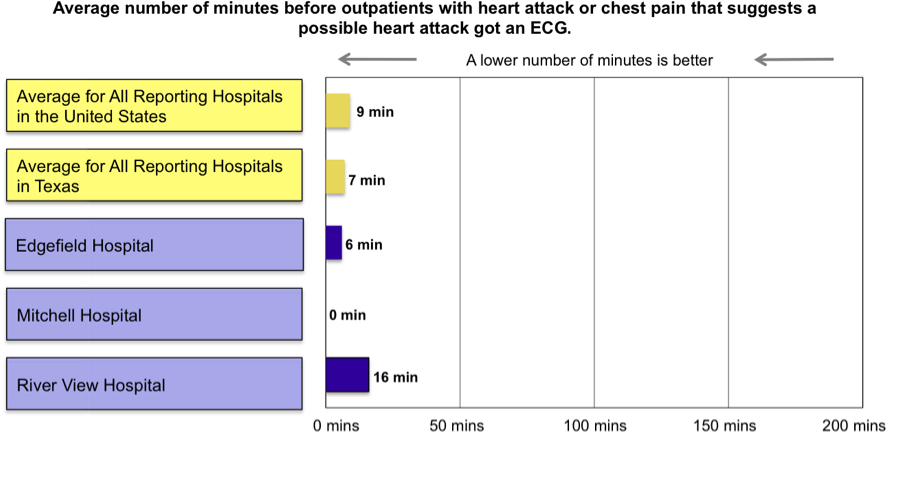CMS-10310.Mockup 3_HA Measures_REV_1_15_v2
CMS-10310.Mockup 3_HA Measures_REV_1_15_v2.doc
Consumer Research on Public Reporting of Hospital Outpatient Measures (CMS-10310)
CMS-10310.Mockup 3_HA Measures_REV_1_15_v2
OMB: 0938-1081
Heart Attack Measures – Tables, Graphs and Explanatory Text

Your Selected Hospitals |
EDGEFIELD HOSPITAL |
MITCHELL HOSPITAL
|
RIVER VIEW HOSPITAL |
||||
Heart Attack or Chest Pain The measures below show how well hospitals are following standards of care known to get the best results for patients with heart attack (or with chest pain that suggests a possible heart attack). These standards are based on medical research. Add text or link here to explain that, for the time being there will be some quarters of data included that have not been validated.
|
|||||||
To view more information, select the topic(s) below and click “View Graphs” or “View Tables.” |
|||||||
|
Outpatient care for heart attack or chest pain |
||||||
|
Select All |
||||||
|
Percent of outpatients with heart attack who got drugs to break up blood clots within 30 minutes of arrival (a higher percentage is better) |
0 patients+ |
0%1 |
40%1 |
|||
|
Average number of minutes before outpatients with heart attack who needed specialized care were transferred to another hospital (a lower number of minutes is better) |
0 patients+ |
14 minutes |
810 minutes |
|||
|
Percent of outpatients with heart attack (or with chest pain that suggests a possible heart attack) who got aspirin within 24 hours of arrival (a higher percentage is better) |
97% |
100%1 |
100%1 |
|||
|
Average number of minutes before outpatients with heart attack (or with chest pain that suggests a possible heart attack) got an ECG (a lower number of minutes is better) |
6 minutes |
0 minutes^ |
16 minutes |
|||
|
Inpatient care for heart attack or chest pain |
|||
|
Percent of heart attack inpatients given aspirin at arrival |
98% |
98% |
100% |
|
Percent of heart attack inpatients given aspirin at discharge |
93% |
99% |
100% |
|
Percent of heart attack inpatients given ACE Inhibitor or ARB for left ventricular systolic dysfunction (LVSD) |
100% |
97% |
95% |
|
Percent of heart attack inpatients given smoking cessation advice/counseling |
100% |
99% |
100% |
|
Percent of heart attack inpatients given beta blocker at discharge |
100% |
97% |
99% |
|
Percent of heart attack inpatients who got medicine to break up blood clots within 30 minutes of arrival |
0 patients+ |
0 patients+ |
0%1 |
|
Percent of heart attack inpatients undergoing a procedure to open blocked blood vessels within 90 minutes of arrival |
0 patients+ |
93% |
89% |
|
Select All |
|||
1 The number of cases is too small to tell how well a hospital is performing.
+ No patients met the criteria to be included for this measure.
^ This average (median) score of 0 minutes means that for at least half of the patients, the ECG was done before the patient arrived in the emergency department (for example, by the ambulance staff).
Alternative Language for Transfer Measure
Version 1
Average number of minutes before outpatients with heart attack who needed specialized care were transferred to another hospital (a lower number of minutes is better)
Version 2
Average number of minutes before outpatients with heart attack who needed specialized care were transferred to another hospital that could give them this care (a lower number of minutes is better)
Term |
Definition |
Outpatient care for heart attack or chest pain |
Most patients who go to the hospital with heart attack or chest pain are treated first in the hospital’s Emergency Department (often called the ER).
If patients are kept in the Emergency Department or given other hospital outpatient services such as observation services, the care they receive is considered "outpatient" care. Also, if patients are transferred to another hospital for more specialized care, the care they receive before the transfer is considered “outpatient” care. |
Term |
Definition |
Inpatient care for heart attack or chest pain |
Most patients who go to the hospital with heart attack or chest pain are treated first in the hospital’s Emergency Department (often called the ER).
If patients are
later admitted to the hospital as an inpatient, all of their care,
including the care they received in the Emergency Department, is
considered “inpatient” care. (This means that their
care is included in the "inpatient" measures only.) |
Heart Attack or Chest Pain
Measures based on standards of care |
Compare the hospitals to this: |
Compare the hospitals to this: |
EDGEFIELD HOSPITAL |
MITCHELL HOSPITAL |
RIVER VIEW HOSPITAL |
UNITED STATES AVERAGE |
TEXAS AVERAGE |
||||
Percent of outpatients with heart attack who got drugs to break up blood clots within 30 minutes of arrival (a higher percentage is better) |
53% |
70% |
0 patients+ |
0% of 1 patient1 |
40% of 5 patients1 |
Average number of minutes before outpatients with heart attack who needed specialized care were transferred to another hospital (a lower number of minutes is better) |
70 minutes |
84 minutes |
0 patients+ |
14 minutes |
810 minutes |
Percent of outpatients with heart attack (or with chest pain that suggests a possible heart attack) who got aspirin within 24 hours of arrival (a higher percentage is better) |
96% |
99% |
97% of 33 patients |
100% of 19 patients1 |
100% of 5 patients1 |
Average number of minutes before outpatients with heart attack (or with chest pain that suggests a possible heart attack) got an ECG (a lower number of minutes is better) |
9 minutes |
7 minutes |
6 minutes |
0 minutes^ |
16 minutes |
1 The number of cases is too small to tell how well a hospital is performing.
+ No patients met the criteria to be included for this measure.
^ This average (median) score of 0 minutes means that for at least half of the patients, the ECG was done before the patient arrived in the emergency department (for example, by the ambulance staff).
Percent of outpatients with heart attack who got drugs to break up blood clots within 30 minutes of arrival.
Why is this important?
Blood clots can cause heart attacks. Certain patients having a heart attack should get a “clot busting” drug to help break up the blood clots and improve blood flow to the heart.
Standards for care say that the clot busting drug should be given within 30 minutes of arrival at the hospital.
This measure tells the percent of patients who got the clot busting drug within 30 minutes of arrival.
The rates displayed in the graph are from data reported for discharges October 2007 through September 2008.

Average number of minutes before outpatients with heart attack who needed specialized care were transferred to another hospital.
Why is this important?
If a hospital does not have the facilities to provide specialized heart attack care, it transfers patients with possible heart attack to another hospital that can give them this care.
This measure shows how long it takes, on average, for hospitals to identify patients who need specialized heart attack care the hospital cannot provide and begin their transfer to another hospital. It shows the average (median) number of minutes it takes from the time patients arrive in the Emergency Department until they are transported to a different hospital.
The rates displayed in the graph are from data reported for discharges October 2007 through September 2008.

Term |
Definition |
Median |
A median is the middle number in a set of numbers that are listed from smallest to largest.
Here’s an example for how long it takes for patients to get a clot busting drug after arrival at the hospital:
If the median number of minutes before patients got the drug is 25 minutes, this means that half of the patients at that hospital got the drug sooner than 25 minutes and half got the drug more than 25 minutes after arrival.
|
Percent of outpatients with heart attack or chest pain that suggests a possible heart attack who got aspirin within 24 hours of arrival.
Why is this important?
Blood clots can cause heart attacks. For many patients having a heart attack, taking aspirin soon after symptoms of a heart attack begin may help break up a clot and make the heart attack less severe. If patients have not taken aspirin themselves before going to the hospital, they should get aspirin when they arrive.
Standards for care say patients should get aspirin within 24 hours before or after arriving at the hospital. This measure tells what percent of patients got aspirin within this time period.
The rates displayed in the graph are from data reported for discharges October 2007 through September 2008.

Average number of minutes before outpatients with heart attack or chest pain that suggests a possible heart attack got an ECG.
Why is this important?
“ECG” (sometimes called EKG) stands for electrocardiogram. An ECG is a test that can help doctors know whether patients are having a heart attack.
Standards of care say that patients with chest pain or a possible heart attack should have an ECG upon arrival, preferably within 10 minutes.
This measure tells the average (median) number of minutes it takes before patients got an ECG.
Sometimes patients get an ECG done before they get to the hospital (for example, by the ambulance staff). This is counted as “0 minutes.”
The rates displayed in the graph are from data reported for discharges October 2007 through September 2008.

| File Type | application/msword |
| File Title | Your Selected Hospitals |
| Author | Kelly Moriarty |
| Last Modified By | sally crelia |
| File Modified | 2010-01-15 |
| File Created | 2010-01-15 |
© 2025 OMB.report | Privacy Policy